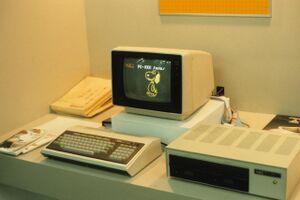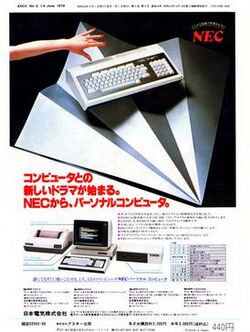Engineering:PC-8000 series
 PC-8001 with monitor and external floppy | |
| Developer | Nippon Electric |
|---|---|
| Manufacturer | New Nippon Electric[1] |
| Type | Home computer |
| Introductory price | 168,000 yen (equivalent to ¥246,603 in 2019) US$1,295 (equivalent to $3,642 in 2019)[2] C$1,495 (equivalent to $3,291 in 2018) |
| Discontinued | January 1983[3] |
| Units sold | 250,000 (PC-8001)[3] |
| Operating system | DISK-BASIC, CP/M |
| CPU | NEC μPD780C (Z80 compatible) @ 4 MHz |
| Memory | ROM 24 KB, RAM 16 KB |
| Graphics | text 80 x 25, graphics 160 x 100, 8 colors |
| Power | AC 100 V 50/60 Hz 20 W |
| Dimensions | 430(W) × 260(D) × 80(H) mm |
| Mass | 4 kg |
| Predecessor | COMPO BS/80 |
| Successor | NEC PC-6001 NEC PC-8801 |
The PC-8000 series (Japanese: PC-8000シリーズ Hepburn: Pī-Shī Hassen Shirīzu) is a line of personal computers developed for the Japan market by NEC. The PC-8001 model was also sold in the United States [4] and Canada as the PC-8001A.[5]
Original models of the NEC PC-8001B (or sometimes the NEC PC-8000) was also sold in some European countries like in the United Kingdom , France , Spain , Italy and the Netherlands and in Australia and New Zealand as well.
PC-8001
The first member of the PC-8000 series, the PC-8001 was first introduced on May 9, 1979,[6] and went on sale September 1979 for ¥168,000.[1][7] Its design combined the keyboard and the mainboard into a single unit. At a time when most micro-computers were sold as "semi-kits" requiring end user assembly, the fully assembled PC-8001 was a rarity in the market. Peripherals included a printer, a cassette tape storage unit, and a CRT interface. Although it is often believed to be the first domestically produced personal computer for the Japanese market, in reality it was preceded by the Hitachi Basic Master.
The PC-8001A was released in the United States in August 1981, and was priced at US$1,295 (32 KB of RAM). It was modified to reduce electromagnetic interference in order to comply with FCC regulations. The Katakana glyphs in the character ROM were replaced with English.[8]
Specification
- CPU: NEC μPD780C (Z80 compatible) running at 4 MHz
- Memory: 16/32 KB
- Text display: 40 columns x 20 lines - 80 columns x 25 lines
- Graphic display: 160x100 pixels, 8 colors [9]
- Operating system: DISK-BASIC, CP/M
- BASIC interpreter: N-BASIC (A variant of Microsoft Disk BASIC 4.51)[10]
Development
In Japan, Nippon Electric's Microcomputer Sales section in the Electronic Device Sales division released the TK-80 in 1976, a single-board computer kit, and it became popular among hobbyists. American personal computers were expensive for personal use (Initial list price of the Apple II was 358,000 yen, and the TRS-80 was 248,000 yen).[11] In addition, computer manufacturers had not developed personal computers because they assumed that the microprocessors of the time were not suitable for computing due to their lack of performance and reliability.[citation needed] In 1978, the Hitachi Basic Master and Sharp MZ-80K, both developed by consumer electronics companies, were released as personal computers targeted for hobbyists, not for business use.[12]
In the summer of 1978, NEC started the development of the PC-8001, codenamed "PCX-1".[1] The development team consisted of 10 engineers including section manager Kazuya Watanabe (渡邊 和也) and chief designer Tomio Gotō (後藤 富雄).[13] They had already planned to release a version of the TK-80BS within a plastic case as a personal computer. It was released as the COMPO BS/80, but it failed in the market due to its poor built-in BASIC and slow clock speed. The PC-8001 was intended to be a high-performance and inexpensive computer for personal use.[12]
When Goto visited Silicon Valley to survey the application of microprocessors, he ran across Kazuhiko Nishi at a computer store. They only exchanged business cards, but Nishi introduced Microsoft to him after he returned to Japan. Goto thought of visiting Microsoft, but he worried that the trip wouldn't be accepted by his boss because Microsoft was a small company. Instead, he attended the fall 1978 West Coast Computer Faire during its first day. The next day, he met Bill Gates at the airport in Albuquerque. After lunch, they went to Microsoft's office, and then Gates told him the importance of having a de facto standard. Goto agreed.[14]
The team had already been developing a BASIC interpreter, but Watanabe decided to adopt Microsoft BASIC because it was widely used in the North American market. At that time, Microsoft and ASCII (the main Microsoft dealer in Japan) intended to expand OEM business in Japan, so N-BASIC was provided for NEC with a very low licence fee.[12] It had been developed at Microsoft's office in Seattle, and NEC provided a wirewrapped prototype, known as the PC-8001g.[15]
The system unit, displays and storage devices were all developed by NEC, and manufactured by New Nippon Electric (NEC Home Electroncs) beginning in January 1980.[13] Printers were provided from Tokyo Electric (Toshiba TEC) because NEC had only developed expensive printers for mainframes.[15]
Success in Japan
The PC-8001 was introduced on May 9, 1979, and the prototype was presented to the public at the Microcomputer Show '79 (マイクロコンピュータショウ'79) held from May 16-19 at the Tokyo Ryūtsū Center. Soon after the exposition, NEC received thousands of orders. It took half a year to ship about 10,000 backorders after shipment began on September 20, 1979.[13][16] By 1981, it dominated 40% of the Japanese personal computer market. About 250,000 units were shipped until production stopped in January 1983.[17] NEC also succeeded in expanding their personal computer chain in Japan. The chain owned 7 stores in 1979, 15 stores in 1980, more than 100 stores in 1981, and reached 200 stores by 1983.[18]
The PC-8001 sold well in the educational market because NEC advertised that the PC-8001 used the industrial standard of Microsoft BASIC.[19] Kanagawa Prefectural Chigasaki Nishihama High School was the first futsu-ka school (upper secondary schools with a focus on a common course) to purchase PC-8001 computers (buying 17 units) and started teaching programming as an elective subject in 1981.[20] In April 1982, NHK Educational TV started the television program "Interest course 'Introduction to Microcomputers' (趣味講座「マイコン入門」)" using the PC-8001. Its textbook "Introduction to Microcomputers - the first half of Showa 57 (マイコン入門 昭和57年度 前期)" sold 700,000 copies.[21]
PC-8001mkII
A higher-performance, more graphically capable revision of the PC-8001, the Mark II debuted in March 1983 for a price of 123,000 yen.
While its most obvious improvement was in its graphical capabilities, the Mark II also included an internal 5.25" floppy disk interface as well as two internal expansion slots, doing away with the need for an "expansion box" to permit upgrades. The internal BASIC was changed as well, from the 24KB N-BASIC to a 32KB "N80-BASIC" that added new conditional statements as well as graphics commands.
While the price of the PC-8001mkII was comparable with other 8-bit computer offerings at the time, its graphics were notably worse than its competitors (most likely an attempt on NEC's part to avoid competing with their own, higher-powered PC-8800 series). This led to a relative dearth of software produced for it, particularly games.
PC-8001mkIISR
A games-oriented revision of the PC-8001mkII with significantly better graphics and sound, making its debut in January 1985 for 108,000 yen.
The mkIISR increased the frame-buffer memory from 16KB to 48KB, allowing for 640×200-pixel graphics or 320×200-pixel double-buffered graphics modes. Additionally, the primitive PC speaker was replaced by an FM synthesis audio system. Its internal BASIC was also updated to allow usage of this new hardware, as well as providing mkII and PC-8001 compatibility modes (although a significant proportion of older software would not run properly under these modes). Other changes included the change of one general-purpose expansion slot to a Kanji character ROM expansion slot, a PC-8800 series keyboard connector, and an Atari-style joystick connector.
Reception
The Japanese personal computer magazine ASCII concluded in 1979 that "Although some problems remain, at present, we can guarantee it is the strongest machine for both software and hardware."[10]
Morichika Sawanobori (沢登 盛親), the division manager of NEC's Electronic Device Sales division, recalled why the PC-8001 became a long seller that "The biggest factor is the price setting of 168,000 yen. The major opinion insisted 220,000 to 230,000 yen was appropriate for value of the product, but Kazuya Watanabe never withdrew 168,000 yen. After all, Watanabe's proposal was accepted by the executive director Ouchi's decision, but his stubbornness was admirable."[13]
Although handicapped by the lack of English documentation, BYTE's American reviewers concluded in January 1981 after evaluating a unit purchased in Japan that "the PC-8001 appears to be an attractive, well-planned, and well-made personal computer ... Most people who have seen our PC-8001 feel that, if it were sold in our country, it would provide strong competition for any of the color-based home computers currently being sold".[22]
References
- ↑ 1.0 1.1 1.2 日本電気社史編纂室 (2001-12-25) (in Japanese). 日本電気株式会社百年史. NEC. pp. 653-654.
- ↑ Hawkins, William J. (1981). "New personal computers". Popular Science 219 (5): 95. https://books.google.co.jp/books?id=Gr9KVVPcNPYC&pg=PA95#v=onepage.
- ↑ 3.0 3.1 小林, 紀興 (1987) (in Japanese). 富士通の大逆襲計画. Kodansha. p. 93. ISBN 4-06-192807-4.
- ↑ Webster, Tony (1981). Microcomputer Buyer's Guide. p. 208. https://books.google.com/books?id=xeYNAQAAMAAJ&q=pc-8001&dq=pc-8001&hl=de&ei=DLrCTdHpF8vXsga6u410&sa=X&oi=book_result&ct=result&resnum=6&ved=0CGcQ6AEwBQ.
- ↑ "Buyer's Guide". Which Micro?: 104. April 1983.
- ↑ "日電と日本マイクロコンピュータ、低価格パソコン相次ぎ新製品発表". Nikkan Kogyo Shimbun: p. 14. 1979-05-10.
- ↑ Cite error: Invalid
<ref>tag; no text was provided for refs namedforster2005 - ↑ "ASCII EXPRESS : PC-8000シリーズ、いよいよアメリカに上陸開始、米国仕様PC-8001Aのスペックは?" (in Japanese). ASCII (ASCII Publishing) 5 (9). 1981. ISSN 0386-5428.
- ↑ http://www.1000bit.it/ad/bro/nec/NECpc8000number2.pdf
- ↑ 10.0 10.1 ASCIIラボラトリーズ (1979). "LOAD TEST No.4: 日本電気株式会社 NEC PC-8001" (in Japanese). ASCII (ASCII Publishing) 3 (11): 34-41. ISSN 0386-5428.
- ↑ 田口, 潤 (1984-10-29). "アップル社の対日戦略:米国産リンゴは日本人の口に合うか" (in Japanese). 日経コンピュータ (Nikkei McGraw-Hill): 71-79. ISSN 0285-4619.
- ↑ 12.0 12.1 12.2 後藤, 富雄 (2006). "日本PC事始 その2: デバイス屋が創ったNECのパーソナル コンピュータ「PC-8001」" (in Japanese) (PDF). Encore (SSIS半導体シニア協会) 45. http://www.ssis.or.jp/ssis/pdf/ENCORE45.pdf. Retrieved 2019-03-23.
- ↑ 13.0 13.1 13.2 13.3 太田, 行生 (1983) (in Japanese). パソコン誕生. 日本電気文化センター. pp. 46-72. ISBN 4-930916-11-9.
- ↑ 大河原, 克行 (2019-08-05). "【大河原克行の「パソコン業界、東奔西走」】ビル・ゲイツとの密会、サードパーティ戦略。いま振り返る「PC-8001」成功物語". Impress Corporation. https://pc.watch.impress.co.jp/docs/column/gyokai/1199709.html.
- ↑ 15.0 15.1 加藤, 明 (2011-06-01). "J-STAGE : 電子情報通信学会 通信ソサイエティマガジン : Vol. 2010 No. 15 : PC-8001の開発" (PDF). Institute of Electronics, Information and Communication Engineers. doi:10.1587/bplus.2010.15_5. https://www.jstage.jst.go.jp/article/bplus/2010/15/2010_15_15_58/_article/-char/ja/. Retrieved 2016-11-03.
- ↑ "急成長続けるパーソナル・コンピュータの国内市場" (in Japanese). 日経エレクトロニクス (Nikkei McGraw-Hill): 188-193. 1981-01-21. ISSN 0385-1680.
- ↑ "日本電気 PC-8001" (in Japanese). パソコン大図鑑 最新・人気パソコン目的別全カタログ. Kodansha. 1981. pp. 30-31. ISBN 4-06-141673-1.
- ↑ 田中, 繁廣 (1988-02-17). "ドキュメント・NECのPC戦略―市場制覇への道を切り拓いた戦士達 その決断と挑戦の歴史" (in Japanese). 100万人の謎を解く ザ・PCの系譜. コンピュータ・ニュース社. pp. 86-89. ISBN 4-8061-0316-0.
- ↑ "PC-9800シリーズ100万台突破を検証する―PCウォッチャー6名の分析" (in Japanese). 100万人の謎を解く ザ・PCの系譜. コンピュータ・ニュース社. 1988-02-17. pp. 62-63. ISBN 4-8061-0316-0.
- ↑ "パソコン特集 : パソコン、着実な歩み : 情報処理教育は普通高校にも". Nihon Keizai Shimbun: p. 33. 1982-04-28.
- ↑ "NHK教育テレビ30周年 比重増す生涯教育番組". Nihon Keizai Shimbun: p. 12. 1989-02-10.
- ↑ Keith, Michael; Kocher, C P (January 1981). "The NEC PC-8001: A New Japanese Personal Computer". BYTE: 72–88. https://archive.org/stream/byte-magazine-1981-01/1981_01_BYTE_06-01_Hand-held_Computers#page/n73/mode/2up. Retrieved 18 October 2013.
External links
- Available software at 2012 and picture of NEC PC-8001
- PC-8001, Oldcomputer.com
| Preceded by COMPO BS/80 |
NEC Personal Computers | Succeeded by NEC PC-6001 NEC PC-8801 |



